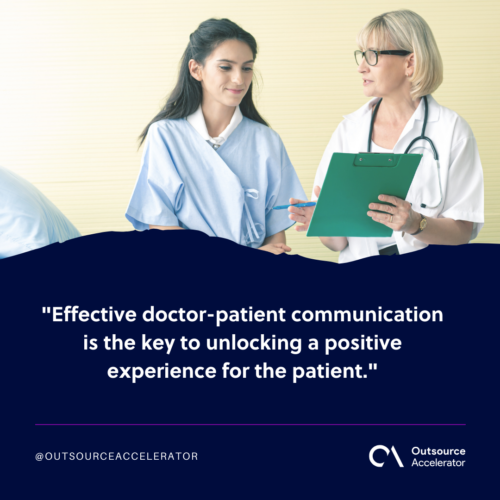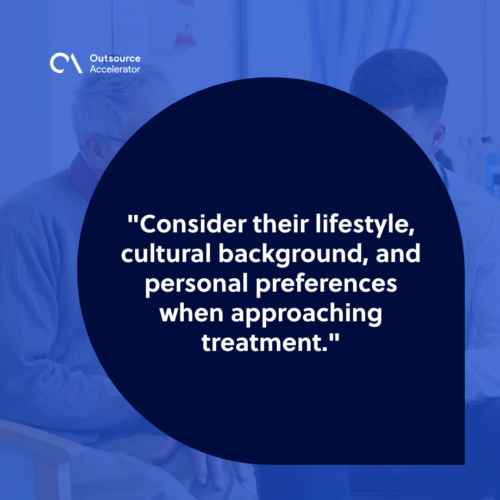Patient experience defined

In the complex and constantly-evolving world of healthcare, the term “patient experience” is at utmost importance.
Let’s delve into the details of what shapes patient experience, the factors influencing it, its benefits, and practical tips to enhance it for the betterment of patients and healthcare providers.
What is patient experience?
Patient experience is a person’s journey from the moment they schedule an appointment until they leave the medical facility. It’s about how they feel, what they remember, and its impact on their well-being.
Factors that affect patient experience
Here are some factors that can influence the overall patient experience:
Doctor-patient communication
Imagine a medical appointment where you and your doctor speak two languages—one in medical jargon and the other in plain English.
Effective doctor-patient communication is the key to unlocking a positive experience for the patient. It involves grasping the diagnosis and understanding the patient’s feelings.
A polite “How are you feeling today?” can go a long way.

Empathy and compassion
Let’s be real; a hospital visit is not on anyone’s bucket list. But what if the staff approached each patient with empathy and compassion?
Small gestures—a comforting hand on the shoulder or a genuine smile—make the journey a bit more bearable.
Empathy humanizes healthcare, turning a cold clinic into a haven of understanding.
Wait times
Waiting in a plain, white room can be frustrating. Cutting down wait times isn’t just a perk; it significantly improves the patient’s overall experience.
Effective scheduling and informing patients about possible delays can transform frustration into understanding.
Environment and amenities
Have you ever walked into a clinic that feels more like a spa than a medical facility? The ambiance matters.
A welcoming environment, soothing colors, and comfortable amenities create a positive patient experience.
Access to information
Knowledge is power, especially when it comes to health. Providing patients with clear, understandable information about their condition, treatment options, and aftercare empowers them to participate actively in their well-being.
Benefits of a positive patient experience
A positive patient experience has numerous benefits for both patients and healthcare providers.
Here are some key advantages:
Improved patient satisfaction
Happy patients are the best advertisement. When patients feel valued and cared for, satisfaction soars. Satisfied patients are likely to stick with a healthcare provider they trust.
Enhanced patient compliance and engagement
Have you noticed why some patients are diligent with their treatment plans while others falter?
Patient experience plays a pivotal role. A great experience fosters a partnership between the patient and the healthcare provider. It leads to better compliance and engagement.
Better health outcomes
The link between patient experience and health outcomes is more profound than meets the eye.
Patients actively participating in their care, following treatment plans, and communicating openly improve health results.
Enhanced population health
Zoom out from individual cases to the broader community. A positive overall experience for patients contributes to improved population health.
When patients are engaged, informed, and satisfied, it creates a ripple effect, fostering a healthier society—one appointment at a time.
Positive word-of-mouth and reputation
In the era of digital reviews and social networking, one’s reputation is significant. A good medical encounter with patients becomes a powerful story, spreading through word-of-mouth and online platforms.
Happy patients share their stories, attracting more individuals to choose a healthcare provider with a stellar reputation.
6 tips to improve patient experience
Improving patient experience involves a combination of factors related to communication, empathy, efficiency, and overall care.
Here are six tips to enhance the patient experience:
Foster open and effective communication
Communication is a two-way street. Encourage healthcare providers to:
- Actively listen
- Ask questions
- Explain complex medical terms in a way that patients can understand.
It’s about engaging in a meaningful dialogue.
Minimize wait times
Time is precious, and no one wants to be idle in a waiting room. Implement efficient scheduling systems, streamline processes, and inform patients about delays.
A well-managed waiting experience can turn frustration into appreciation.
Tailor personalized care to the patient
One size does not fit all in healthcare. Tailor care plans to the individual needs and preferences of each patient.
Consider their lifestyle, cultural background, and personal preferences when approaching treatment. Personalization creates a connection that goes beyond the clinical setting.
Improve access to information
Transparency is key. Provide patients with clear, understandable information about their condition, treatment options, and what to expect.
Use user-friendly formats and encourage questions. An informed patient is an empowered patient.
Create a comfortable environment
Transform the clinical atmosphere into a welcoming space. Consider the aesthetics, lighting, and amenities to create a positive ambiance.
Small touches like comfortable seating and soothing colors can significantly impact the overall experience.
Actively seek feedback from patients
The best way to improve is to listen. Actively seek feedback from patients about their experiences.
Use surveys, suggestion boxes, or digital platforms to gather insights. Utilizing patient feedback is an invaluable resource for ongoing enhancement.
The essence of patient experience
In a world full of choices, delivering an outstanding patient experience is not just an extra benefit; it’s a requirement. It goes beyond treating illnesses; it involves:
- Healing with empathy
- Establishing trust
- Leaving a lasting impression on everyone who walks into the clinic.
As we navigate the complex web of patient experience, let’s remember it’s not a mere checkbox on a form; it’s a dynamic process that evolves with each interaction.
Patient experience is the heartbeat of healthcare, and by embracing its true essence, we pave the way for a healthier, happier future—where every patient feels not just seen but genuinely cared for.








 Independent
Independent




